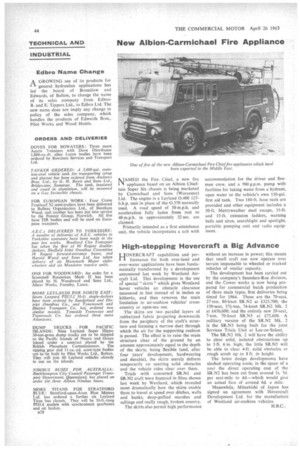High-stepping Hovercraft a Big Advance
Page 46

If you've noticed an error in this article please click here to report it so we can fix it.
HOVERCRAFT capabilities and performance for both over-land and over-water applications have been fundamentally transformed by a development announced last week by Westland Aircraft Ltd. This development is the use of special " skirts " which gives Westland hover vehicles an obstacle clearance measured in feet instead of in inches as hitherto, and thus removes the main limitation to air-cushion vehicles' crosscountry or open-sea use.
The skirts are two parallel layers of rubberized fabric projecting downwards from the periphery of the craft's structure and forming a narrow duct through which the air for the supporting cushion is passed. The effect is to raise the main structure clear of the ground by an amount approximately equal to the depth of the skirts: being flexible (and, after four years' development, hardwearing and durable), the skirts merely deform temporarily on meeting solid obstacles and the vehicle rides clear over them.
Trials with converted SR.N1 and SR.N2 craft were featured in films shown last week by Westland, which revealed most dramatically how the skirts enable them to travel at speed over ditches, walls and banks, deep-gullied marshes and saltings and really rough, broken country.
The skirts also permit high performance
without an increase in power; this means that small craft can now operate over terrain impassable to wheeled or tracked vehicles of similar capacity.
The development has been carried out by the company's Saunders-Roe division, and the Cowes works is now being prepared for commercial batch production of three main types, first deliveries being timed for 1964. These are the 70-seat, 27-ton, 80-knot SR.N2 at £325,700; the 150-seat, 37-}-ton, 74-knot SR.N2 Mk. 2 at £450,600; and the entirely new 20-seat, 7-ton, 70-knot SR.N5 at £75,600. A military version of the SR.N2 Mk. 2 is the SR.N3 being built for the joint Services Trials Unit at Lee-on-Solent.
The SR.N2 Mk. 2 will have the ability to clear solid, isolated obstructions up to 3 ft. 6 in. high; the little SR.N5 will be able to clear 4-ft. solid obstacles or rough scrub up to 8 ft. in height.
The latest design developments have slashed operating costs; in the space of a year the direct operating cost of the SR.N2 has been cut from around Is. 3d. per seat-mile to 4d.—which would give an actual fare of around 6d. a mile.
Meanwhile, Mitsubishi of Japan has signed an agreement with Hovercraft Development Ltd. for the manufacture of Westland air-cushion vehicles.












































































































